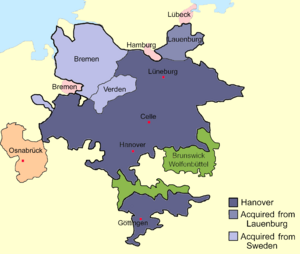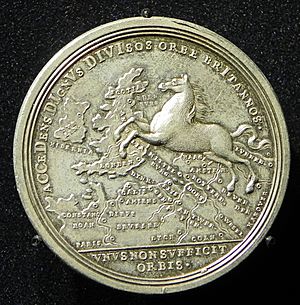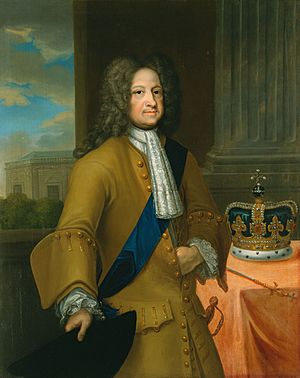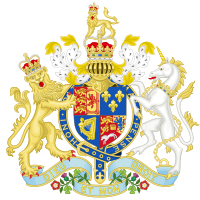George I of Great Britain facts for kids
Quick facts for kids George I |
|||||
|---|---|---|---|---|---|
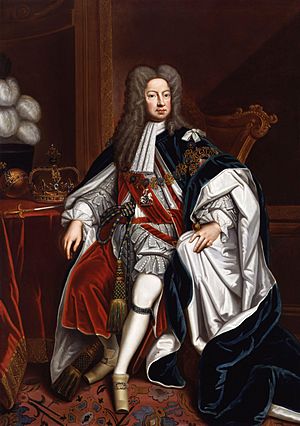
Portrait from the studio of Godfrey Kneller, 1714
|
|||||
| King of Great Britain and Ireland (more...) | |||||
| Reign | 1 August 1714 – 11 June 1727 | ||||
| Coronation | 20 October 1714 | ||||
| Predecessor | Anne | ||||
| Successor | George II | ||||
| Elector of Hanover | |||||
| Reign | 23 January 1698 – 11 June 1727 | ||||
| Predecessor | Ernest Augustus | ||||
| Successor | George II | ||||
| Born | 28 May / 7 June 1660 (O.S./N.S.) Hanover, Brunswick-Lüneburg, Holy Roman Empire |
||||
| Died | 11/22 June 1727 (aged 67) (O.S./N.S.) Schloss Osnabrück, Osnabrück, Holy Roman Empire |
||||
| Burial | 4 August 1727 Leine Palace, Hanover; later Herrenhausen, Hanover |
||||
| Spouse | |||||
| Issue more... |
|||||
|
|||||
| House | Hanover | ||||
| Father | Ernest Augustus, Elector of Hanover | ||||
| Mother | Sophia of the Palatinate | ||||
| Religion | Protestant | ||||
| Signature | |||||
George I (born George Louis; 28 May 1660 – 11 June 1727) was the King of Great Britain and Ireland from 1714 until his death in 1727. He was also the ruler of the Electorate of Hanover within the Holy Roman Empire from 1698.
George was the first British king from the House of Hanover. He became king because he was the closest Protestant relative of his great-grandfather, James VI and I. He was born in Hanover to Ernest Augustus and Sophia of Hanover. George inherited lands in Germany, and his power grew through wars. In 1708, he became a prince-elector of Hanover.
In 1714, after his mother Sophia and his second cousin Anne, Queen of Great Britain died, George became the British king. This happened because of the Act of Settlement 1701, which said only Protestants could inherit the throne. Some people, called Jacobites, tried to remove George and put Anne's Catholic half-brother, James Francis Edward Stuart, on the throne, but they failed.
During George's time as king, the power of the monarch became less strong. Britain started to move towards a system where the government was led by a cabinet and a prime minister. Towards the end of his rule, Robert Walpole held most of the political power and is seen as Britain's first unofficial prime minister. George I died from a stroke while visiting Hanover and was buried there. He is the last British king to be buried outside the United Kingdom.
Contents
Early Life and Family
George was born on 28 May 1660 in Hanover, a city in the Holy Roman Empire. He was the oldest son of Ernest Augustus, Duke of Brunswick-Lüneburg, and Sophia of Hanover. His mother, Sophia, was the granddaughter of King James I of England.
For his first year, George was the only heir to his father's German lands. His brother, Frederick Augustus, was born in 1661. Their mother, Sophia, was very involved in their upbringing. She described George as a responsible and careful child who was a good example for his younger brothers and sisters.
By 1675, George's older uncles had died without sons. This made George's future inheritance more certain. His father, Ernest Augustus, trained George in military matters. At age fifteen, George joined his father in the Franco-Dutch War to gain battle experience.
In 1679, another uncle died without sons. This meant George's family was set to inherit more land. In 1682, the family agreed to a rule called primogeniture. This meant George would inherit all the land instead of sharing it with his brothers.
Marriage and Children

In 1682, George married Sophia Dorothea of Celle, who was his cousin and the daughter of his uncle, George William. This marriage was mainly arranged to bring more money and land to the family. It helped to unite the regions of Hanover and Celle.
In 1683, George and his brother Frederick Augustus fought in the Great Turkish War. That same year, Sophia Dorothea gave birth to their son, George Augustus. A year later, Frederick Augustus learned about the primogeniture rule, which meant he would not inherit land as he had expected. This caused problems between him and his father, and between the brothers, until Frederick Augustus died in 1690.
George and Sophia Dorothea had a second child, a daughter also named Sophia Dorothea, in 1687. However, their marriage became difficult. George preferred the company of his long-term companion, Melusine von der Schulenburg.
George's marriage to Sophia Dorothea ended. She was kept at Ahlden House in Celle, where she lived for over thirty years. She was not allowed to see her children or father, or to remarry. However, she had an income, a home, and servants. Melusine von der Schulenburg was George's hostess from 1698 until his death. They had three daughters together.
Becoming an Elector and Heir
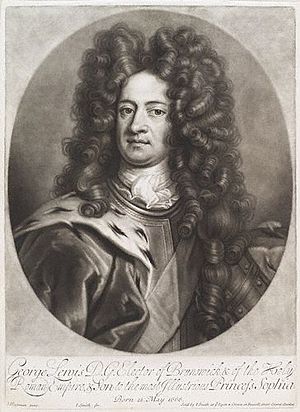
When George's father, Ernest Augustus, died on 23 January 1698, George inherited all his lands. He became the Duke of Brunswick-Lüneburg (also known as Hanover) and a Prince-Elector of the Holy Roman Empire. His court in Hanover was a center for famous thinkers and artists like the mathematician Gottfried Leibniz and the composer George Frideric Handel.
Soon after George became Duke, Prince William, Duke of Gloucester, who was second in line to the English and Scottish thrones, died. According to the English Act of Settlement 1701, George's mother, Sophia, was named the heir to the English throne. This was because she was the closest Protestant relative to the British royal family. Many Catholics with stronger family claims were passed over because of this law.
In 1701, George received the Order of the Garter. Six weeks later, the former King James II, the closest Catholic claimant, died. When Queen Anne became queen in 1702, Sophia became the official heir. Sophia was 71 but very healthy and worked hard to secure the succession for herself or her son. George understood British politics well. In 1705, new laws were passed to make Sophia and her heirs English subjects. In the same year, George inherited more German lands when his last uncle died.
Soon after George became ruler of Hanover, the War of the Spanish Succession began. This war was about who would become king of Spain. Many European countries, including England and Hanover, did not want the French royal family to control Spain as well, fearing they would become too powerful. George led his army and successfully invaded a neighboring pro-French state. As a result, Hanover gained more land.
In 1707, George became an Imperial Field Marshal, leading the imperial army. Although his time in command had some challenges, the German princes were pleased with his efforts. In 1708, they officially confirmed his position as a Prince-Elector. George stopped active military service in 1709. The war ended in 1713 with the Treaty of Utrecht, which kept the Spanish and French thrones separate.
Becoming King of Great Britain
Both England and Scotland recognized Queen Anne as their ruler. However, only the English Parliament had agreed that Sophia, Electress of Hanover, would be the next in line. The Scottish Parliament had not. In 1703, Scotland passed a law saying their next ruler would not be the same as England's unless England allowed Scottish merchants full trade freedom.
Eventually, in 1707, both Parliaments agreed to a Treaty of Union. This joined England and Scotland into one country, the Kingdom of Great Britain. It also set the rules for who would become king or queen, following the Act of Settlement 1701. This union created a large free trade area in Europe.
Some politicians, called Whigs, believed Parliament had the right to choose the next ruler. Others, called Tories, thought the Catholic Stuarts had a stronger family claim. In 1710, George stated that he would become king by hereditary right, meaning it was his by birth, but that the Stuarts had lost their right. This was to show the Tories he was not just chosen by Parliament.
George's mother, Electress Sophia, died on 28 May 1714. George then became Queen Anne's direct heir. Anne's health was failing, and she died on 1 August 1714. George was immediately proclaimed King of Great Britain and Ireland. He arrived in Britain on 18 September and was crowned at Westminster Abbey on 20 October. His coronation led to some riots in England.
After 1714, George mainly lived in Great Britain. However, he visited Hanover several times. During his absences, a group of regents (a Regency Council) governed the country, rather than his son, George Augustus, Prince of Wales.
Wars and Rebellions

Within a year of George becoming king, the Whigs won a big election in 1715. Many members of the losing Tory Party supported the Jacobites. The Jacobites wanted to replace George with Anne's Catholic half-brother, James Francis Edward Stuart.
Some unhappy Tories joined a Jacobite rebellion known as "The Fifteen." James's supporters started the rebellion in Scotland, where Jacobite support was stronger. However, the rebellion failed. James arrived late with too little money and weapons. By early 1716, the rebellion had almost collapsed, and James fled to France. After the rebellion was defeated, George showed leniency. He used money from seized estates to fund schools in Scotland and help pay off the national debt.
George did not trust the Tories, which helped the Whigs stay in power for a long time. The Whig-controlled Parliament passed the Septennial Act 1715, which allowed Parliament to last for up to seven years. This meant the Whigs could stay in power longer.
George's relationship with his son, George Augustus, Prince of Wales, was always difficult and got worse after George became king. His son often opposed his father's policies. In 1717, a major argument happened when a grandson was born. The King and the Prince of Wales were later reconciled, but they never became truly friendly again.
George was active in shaping Britain's foreign policy. In 1717, he helped create the Triple Alliance with Great Britain, France, and the Dutch Republic to oppose Spain. In 1718, the Holy Roman Empire joined, forming the Quadruple Alliance. This led to the War of the Quadruple Alliance. Spain supported a Jacobite invasion of Scotland in 1719, but it failed quickly. Hanover also gained from the end of the Great Northern War, receiving the Swedish territories of Bremen and Verden.
Government and Challenges

In Hanover, George was an absolute ruler, meaning he had complete control. But in Great Britain, he had to govern with Parliament.
In 1715, when the Whigs came to power, George's main ministers included Robert Walpole, Lord Townshend, Lord Stanhope, and Lord Sunderland. Over time, some ministers resigned due to disagreements. Walpole and Townshend returned to government in 1720.
A big problem arose from financial speculation and the national debt. In 1719, the South Sea Company offered to take over a large part of Britain's national debt. The company's stock prices rose very quickly, leading to a speculative bubble. Many people invested and lost huge amounts of money when the stock prices crashed in 1720. This event was known as the South Sea Bubble.
George, who was in Hanover, returned to London earlier than planned because of the crisis. The economic crisis made George and his ministers very unpopular. In 1721, Lord Stanhope died, and Lord Sunderland resigned.
Robert Walpole then became the most powerful minister, effectively the first Prime Minister. He helped stabilize the financial situation by reorganizing the debts. Walpole's skill in managing Parliament helped George avoid direct blame for the company's problems. Records show that George paid for his shares and lost money in the crash.
Later Years and Death
At Walpole's request, George brought back the Order of the Bath in 1725. This allowed Walpole to reward his political supporters. Walpole became very powerful and could choose most of the ministers. Unlike Queen Anne, George rarely attended cabinet meetings. He mostly influenced British foreign policy. With Lord Townshend's help, he arranged the Treaty of Hanover in 1725 to protect British trade.
George still had the power to replace his ministers, but he relied heavily on Walpole. George died during his sixth trip to Hanover. He suffered a stroke on 9 June 1727 and died in the early hours of 11 June 1727. George I was buried in Hanover. His remains were later moved to the chapel at Herrenhausen Gardens after World War II.
His son, George Augustus, became King George II. Many people thought George II would remove Walpole from office, but Walpole had strong support in Parliament. George II had little choice but to keep him to avoid political instability.
Legacy

Some people in Britain made fun of George I. They thought he was not smart because he seemed stiff in public. It was also believed he could not speak English, but later in his reign, documents show he understood, spoke, and wrote English. He was fluent in German and French, and knew some Latin and Italian.
His treatment of his wife, Sophia Dorothea, caused some scandal. His Lutheran faith and the presence of Lutheran preachers in his court also caused some concern among his Anglican subjects.
Many British people saw George as "too German." However, in Europe, he was seen as a modern ruler who supported the Age of Enlightenment. He allowed critics to publish freely and even gave Voltaire a safe place when the philosopher was exiled from Paris. Both European and British sources agree that George was quiet, calm, and careful with money. He did not like public social events and often traveled secretly to friends' homes to play cards.
Despite some unpopularity, most of his subjects saw the Protestant George I as a better choice than the Catholic claimant, James. Historians have re-examined George's life and rule in recent times. They now see his character, abilities, and reasons in a more positive light.
George I's true personality remains a bit mysterious. He could be kind and loving in private letters to his daughter, but seemed dull and awkward in public. His mother once said he could be jolly and felt things deeply, but did not like to show it. Whatever his true character, he took over a difficult throne and left it secure for his family, the Hanoverians, and for Parliament.
Arms
As King, his coat of arms looked like this:
| Arms of George I Louis as Elector-Designate of Hanover 1689–1708 | Arms of George I Louis as Elector of Hanover 1708–1714 | Coat of arms of George I as King of Great Britain 1714–1727 |
Issue

George I had children with his wife, Sophia Dorothea of Celle, and with his long-term companion, Melusine von der Schulenburg.
| Name | Birth | Death | Marriage |
|---|---|---|---|
| By his wife, Sophia Dorothea of Celle: | |||
| George II of Great Britain | 9 November 1683 | 25 October 1760 | Married 1705 Caroline of Ansbach; had issue |
| Sophia Dorothea of Hanover | 26 March 1687 | 28 June 1757 | Married 1706 Frederick William, Margrave of Brandenburg (later Frederick William I of Prussia); had issue |
| By his companion, Melusine von der Schulenburg: | |||
| (Anna) Louise Sophia von der Schulenburg | January 1692 | 1773 | Married 1707 Ernst August Philipp von dem Bussche-Ippenburg (divorced before 1714); created Countess of Delitz by Charles VI, Holy Roman Emperor, in 1722 |
| (Petronilla) Melusina von der Schulenburg | 1693 | 1778 | Created Countess of Walsingham for life; married 1733 Philip Stanhope, 4th Earl of Chesterfield; no issue |
| Margarethe Gertrud von Oeynhausen | 1701 | 1726 | Married 1722 Albrecht Wolfgang, Count of Schaumburg-Lippe |
| Dates in this table are New Style. | |||
Family Tree
| Family of George I of Great Britain | ||||||||||||||||||||||||||||||||||||||||||||||||||||||||||||||||||||||||||||||||||||||||||||||||||||||||||||||||||||||||||||||||||||||||||||||||||||||||||||||||||||||||||||||||||||||||||||||||||||||||||||||||||||||||||||||||||||||||||||||||||||||||||||||||||||||||||||||||||||||||||||||||||||||||||||||||||||||||||||||||||||||||||||||||||||||||||||||||||||||||||||||||||||||||||||||||||||||||||||||||||||||||||||||||||||||||||||||||||||||||||||||||||||||||||||||||||||||||||||||||||||||||||||||||
|---|---|---|---|---|---|---|---|---|---|---|---|---|---|---|---|---|---|---|---|---|---|---|---|---|---|---|---|---|---|---|---|---|---|---|---|---|---|---|---|---|---|---|---|---|---|---|---|---|---|---|---|---|---|---|---|---|---|---|---|---|---|---|---|---|---|---|---|---|---|---|---|---|---|---|---|---|---|---|---|---|---|---|---|---|---|---|---|---|---|---|---|---|---|---|---|---|---|---|---|---|---|---|---|---|---|---|---|---|---|---|---|---|---|---|---|---|---|---|---|---|---|---|---|---|---|---|---|---|---|---|---|---|---|---|---|---|---|---|---|---|---|---|---|---|---|---|---|---|---|---|---|---|---|---|---|---|---|---|---|---|---|---|---|---|---|---|---|---|---|---|---|---|---|---|---|---|---|---|---|---|---|---|---|---|---|---|---|---|---|---|---|---|---|---|---|---|---|---|---|---|---|---|---|---|---|---|---|---|---|---|---|---|---|---|---|---|---|---|---|---|---|---|---|---|---|---|---|---|---|---|---|---|---|---|---|---|---|---|---|---|---|---|---|---|---|---|---|---|---|---|---|---|---|---|---|---|---|---|---|---|---|---|---|---|---|---|---|---|---|---|---|---|---|---|---|---|---|---|---|---|---|---|---|---|---|---|---|---|---|---|---|---|---|---|---|---|---|---|---|---|---|---|---|---|---|---|---|---|---|---|---|---|---|---|---|---|---|---|---|---|---|---|---|---|---|---|---|---|---|---|---|---|---|---|---|---|---|---|---|---|---|---|---|---|---|---|---|---|---|---|---|---|---|---|---|---|---|---|---|---|---|---|---|---|---|---|---|---|---|---|---|---|---|---|---|---|---|---|---|---|---|---|---|---|---|---|---|---|---|---|---|---|---|---|---|---|---|---|---|---|---|---|---|---|---|---|---|---|---|---|---|---|---|---|---|---|---|---|---|---|---|---|---|---|---|---|---|---|---|---|---|---|---|---|---|---|---|---|---|---|---|---|---|---|---|---|---|---|---|---|---|---|---|---|---|---|---|---|---|---|---|---|---|---|---|---|---|---|---|---|---|---|---|---|---|---|---|---|---|---|---|---|---|---|---|---|---|---|---|---|---|---|---|---|---|---|
|
||||||||||||||||||||||||||||||||||||||||||||||||||||||||||||||||||||||||||||||||||||||||||||||||||||||||||||||||||||||||||||||||||||||||||||||||||||||||||||||||||||||||||||||||||||||||||||||||||||||||||||||||||||||||||||||||||||||||||||||||||||||||||||||||||||||||||||||||||||||||||||||||||||||||||||||||||||||||||||||||||||||||||||||||||||||||||||||||||||||||||||||||||||||||||||||||||||||||||||||||||||||||||||||||||||||||||||||||||||||||||||||||||||||||||||||||||||||||||||||||||||||||||||||||
Images for kids
See also
 In Spanish: Jorge I de Gran Bretaña para niños
In Spanish: Jorge I de Gran Bretaña para niños


